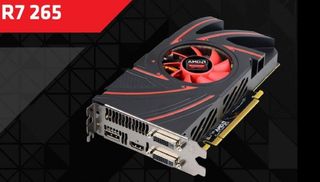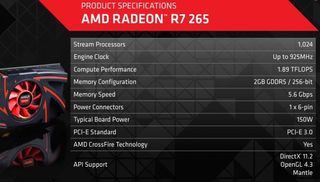AMD and Nvidia's new budget cards do battle this week

There's a big showdown happening in the world of affordable graphics cards this week. AMD and Nvidia are releasing the latest editions in their £100 / $150 range, an important battleground, given that cards at that range easily outsell their flashy flagship $1000 tech. AMD are bringing some rebranded and boosted versions of their last-gen GPUs to compete with Nvidia's GTX 750Ti and GTX 750, which will give us our first look at their new Maxwell GPU architecture.
The first of AMD's crop: the R7 250X. In reality it's just a rebranded HD 7770 from the last generation. That's not such a bad thing given that they could have gone with a boosted Oland GPU from the weak-heart R7 250. The Cape Verde XT GPU comes with 640 cores compared with the 384 of the R7 250, and isn't a half-bad gaming chip. At 1080p the HD 7770 was could hit 30FPS, and nothing has changed apart from the badge and the price.
AMD have also announced the R7 265. Again this isn't a new part, but it does at least mean we'll see the HD 7850 return for another bow. The R7 265 will boast a higher clockspeed than the GPU it's supplanting. Even without the TrueAudio tech in the 260X's Bonnaire chip, it should deliver impressive performance at around £125 / $175.

This new AMD re-brandathon is probably down to the fresh technology in Nvidia's GTX 750Ti and GTX 750. They will represent our first look at Maxwell, even if they are still being made on the familiar 28nm production process. According to the rumours doing the rounds the new Maxwell GPUs offer unprecedented levels of power efficiency - something that's of massive importance given the rise in small form factor gaming recently.
Stay tuned for the GeForce review soon.
The biggest gaming news, reviews and hardware deals
Keep up to date with the most important stories and the best deals, as picked by the PC Gamer team.

Dave has been gaming since the days of Zaxxon and Lady Bug on the Colecovision, and code books for the Commodore Vic 20 (Death Race 2000!). He built his first gaming PC at the tender age of 16, and finally finished bug-fixing the Cyrix-based system around a year later. When he dropped it out of the window. He first started writing for Official PlayStation Magazine and Xbox World many decades ago, then moved onto PC Format full-time, then PC Gamer, TechRadar, and T3 among others. Now he's back, writing about the nightmarish graphics card market, CPUs with more cores than sense, gaming laptops hotter than the sun, and SSDs more capacious than a Cybertruck.
Most Popular

